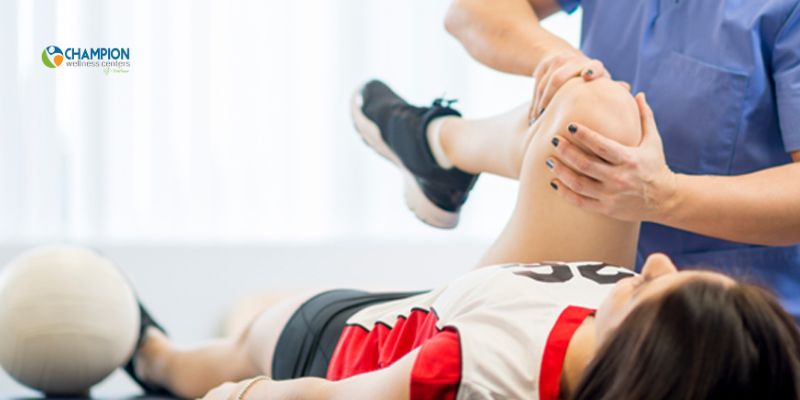Most fall sports often involve running. During this time, cross-country running, soccer or football, volleyball, lacrosse and tennis are common activities. They all require repetitive motion. Due to their demands, injuries can happen.
Common Fall Sports Injuries

Fall sports are a big part of people’s lives. This season often sees an increase in schedules and tournaments, with many individuals and teams participating in different sporting activities. Some injuries are common with fall sports because of the physical demands. Here are the common fall sports injuries you should know…
1. Elbow Injury

Many sports-related injuries involve the elbow, and it is especially common in fall sports. Tennis elbow is not limited to tennis players but can develop in individuals who repetitively strain their elbow in various sports. This strain can cause small tears in the ligaments which may result in gradual pain and inflammation.
If you experience persistent elbow discomfort, the recommended approach often involves rest, icing and the use of anti-inflammatory medication. To prevent tennis elbow, consider including forearm-strengthening exercises in your routine. Additionally, elbow braces can be effective.
2. Shoulder Injury
The shoulder requires protection during sports. It is a complex joint that frequently suffers issues including minor strains, sprains and dislocations. Sports such as volleyball, basketball, tennis and swimming where there is repetitive arm movement overhead can put significant stress on the shoulder.
In football, tackles often lead to forceful impacts directly targeting the shoulder. If you suffer this injury, you can alleviate the discomfort through anti-inflammatory medication, rest and icing. If these are not effective, you can consult a chiropractor.
3. Sprains
Sprains refer to the stretching or tearing of ligaments, which connect and stabilize bones within a joint. The majority of sprains happen when you twist a part of your body uncomfortably. Fall sports are known to be associated with a variety of sprains, affecting areas ranging from elbows to ankles and knees.
Additionally, sports like soccer where hands are not typically used can lead to hand injuries if you fall and land awkwardly on your hand. Given the physical demands of these activities, preventing sprains can be challenging but it is possible with the right precautions.
4. Knee Injuries
Approximately half of sports injuries involve the knees. Football or soccer often leads to knee injuries due to tackles and collisions happening around the knee area. Over time, knees can also wear out from repetitive motion. Additionally, activities like running, volleyball, swimming and cycling can trigger knee problems.
If you are experiencing regular knee pain, consider switching to a gentler, low-impact sport. Another tip? Ensure your shoes fit well and provide proper support to also prevent this type of injury.
5. Concussion
A concussion is a major injury concern in any season. Sports involving contact, like football or soccer, frequently involve powerful head impacts. Regularly hitting the ball with your head in these sports can lead to concussions.
However, not every head bump results in a concussion, but it can happen even after what seems like a minor hit to the head. So, regardless of the sport or season, protecting your head and being cautious is crucial to prevent these serious injuries.
Tips On How To Prevent Common Fall Sports Injuries
You can prevent the common types of fall sports injuries by following the right recommendations. Below are tips to help you avoid some of these injuries…
- Proper warm-up: Ensuring your body is flexible and prepared can help prevent sports injuries. This involves starting with gentle stretches before engaging in any game or practice. Avoid diving straight into intense activities or sprints so that your body will be able to move smoothly and reduce the risk of injuries.
- Cross-train: Having a stronger body can help in handling strains and pressure. To prevent many fall sports injuries, you can diversify your physical activities by engaging in something different from your primary sport at least once a week. This approach allows you to work on different muscle groups.
- Use the field and/or court in good condition: Avoid playing on a field or court in poor condition as it can result in injuries. For instance, if as a soccer player, you are sprinting down the field and unexpectedly get your foot stuck in a hole or uneven surface, it can lead to an ankle sprain or even more severe injuries.
- Use high-quality materials: Participating in sports can be costly. Speak with teammates to find reliable sources for high-quality equipment. Coaches or trainers may also offer guidance. It is also possible to locate dentists or dental trainees willing to offer you complimentary mouthguards as part of a public service initiative.
- Change positions: Consistently playing the same position means you perform the same actions repeatedly. This repetitive movement can result in inflammation of the tendons, inflammation of the bursa sacs, tendonitis and bursitis. While you gain experience in your primary position, it is important to change your movements on the field to prevent these injuries caused by repetitive motions.
- Rest after suffering an injury: Athletes often have a competitive drive, wanting to quickly get back to the field. Many may attempt to shorten their recommended recovery time, but only resume playing when you have received approval from your medical professional.
- Refresh your body: Your body can resist injury better when you are physically strong. Consume a well-balanced diet rich in calcium to strengthen your bones. The early months of fall can still be quite hot, so ensure you maintain proper hydration levels during practice/games as well.
Summary:
Understanding and addressing common fall sports injuries is necessary for athletes of all levels. By prioritizing proper warm-up routines, cross-training and following medical advice, you can significantly reduce your risk of injury and enjoy a safe and active fall sports season.



